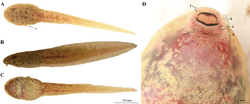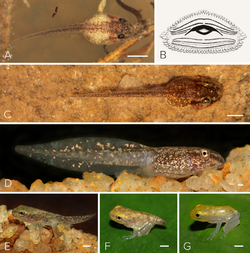Biology:Gosner stage

Gosner stage is a generalized system of describing stages of embryonal and larval development in anurans (frogs and toads). The Gosner system includes 46 numbered stages, from fertilized embryo (stage 1) to the completion of metamorphosis (stage 46). It was introduced by Kenneth Gosner in 1960.[2] The system is widely used in herpetology[3][4][5][6] to describe exotrophic tadpoles.[3] Gosner stages are based on certain morphological landmarks that allow comparing development in different species that may greatly differ in age or size.[3]
Developmental stages

The Gosner system includes 46 stages, from fertilized embryo (stage 1) to the completion of metamorphosis (stage 46). In the original publication, only two major developmental stages were distinguished, embryonic or prefeeding stages (1–25) and larval stages (26–46).[2] McDiarmid and Altig (1999) distinguish four major developmental stages, as detailed in the table below.[3]
| Developmental category | Gosner stages | Description |
|---|---|---|
| Embryo | 1 to 20 (about) | Intracapsular. Development through cleavage, gastrulation, and appearance of neural tube and eventually gills and tail. |
| Hatchling | 21 (about) to 24 | Transition from relatively immobile embryo to an active, feeding tadpole. Specimens at these stages may sometimes be referred to as "larvae". |
| Tadpole | 25 to 41 | Longest part of larval period that is marked by growth and development of limbs. The generic term "larvae" often refers to these stages. |
| Metamorph | 42 to 46 | Loss of larval characters and development of adult structures; typically associated with the transition from the aquatic to the terrestrial habitats |
In ecological literature, the term "hatchling" may refer to stages 24–26.[3] However, for direct-developing species, hatching occurs in the end of the development.[5]
Limitations
As a generalized system, Gosner stages may not be adequate for describing development of some anuran tadpoles.[3] For example, in the torrent-dwelling tadpoles of Ansonia longidigita and Meristogenys orphnocnemis, the usual Gosner stages become inappropriate beyond the stage 41 because the tadpoles retain their oral disc longer than the system depicts. This is interpreted as an adaptation that allows the tadpoles to cling to the rocks until the tail is almost fully resorbed.[8] In Limnonectes limborgi, the tadpoles are free-living but non-feeding ("nidicolous") and retain their yolk sac until stage 37, at least.[9] Direct-developing frogs hatch directly as froglets, without free-living larval stage.[3]
References
- ↑ Li, Shize; Wei, Gang; Xu, Ning; Cui, Jianguo; Fei, Liang; Jiang, Jianping; Liu, Jing; Wang, Bin (2019). "A new species of the Asian music frog genus Nidirana (Amphibia, Anura, Ranidae) from Southwestern China". PeerJ 7: e7157. doi:10.7717/peerj.7157.
- ↑ 2.0 2.1 Gosner, Kenneth L. (1960). "A simplified table for staging anuran embryos and larvae with notes on identification". Herpetologica 16 (3): 183–190.
- ↑ 3.0 3.1 3.2 3.3 3.4 3.5 3.6 McDiarmid, Roy W.; Altig, Ronald (1999). Tadpoles: The Biology of Anuran Larvae. University of Chicago Press. pp. 8–11. ISBN 978-0-226-55762-5. https://books.google.com/books?id=77fPT1qk_9AC&pg=PA8.
- ↑ Beebee, Trevor J. C. (1996). Ecology and conservation of amphibians. London: Chapman and Hall. pp. 16–17. ISBN 978-0-412-62410-0.
- ↑ 5.0 5.1 Vitt, Laurie J.; Caldwell, Janalee P. (2014). Herpetology: An Introductory Biology of Amphibians and Reptiles (4th ed.). Academic Press. pp. 43–44.
- ↑ "Amphibian Development Charts". Virginia Herpetological Society. http://www.virginiaherpetologicalsociety.com/amphibians/amphibian-development/amphibian-development.htm. Retrieved 16 July 2019.
- ↑ Abraham, Robin Kurian; Mathew, Jobin Kuruvilla; Raju, David Valiaparampil; Rao, Ramprasad; Zachariah, Anil (2018). "Reproduction and metamorphosis in the Myristica Swamp tree frog, Mercurana myristicapalustris (Anura: Rhacophoridae)". PeerJ 6: e5934. doi:10.7717/peerj.5934. PMID 30498632.
- ↑ Nodzenski, Edwardine; Inger, Robert F. (1990). "Uncoupling of related structural changes in metamorphosing torrent-dwelling tadpoles". Copeia 1990 (4): 1047–1054. doi:10.2307/1446488.
- ↑ Rowley, Jodi J. L.; Altig, Ronald (2012). "Nidicolous development in Limnonectes limborgi (Anura, Dicroglossidae)". Amphibia-Reptilia 33: 145–149. doi:10.1163/156853812X626179.
External links
- Amphibian Development Charts by the Virginia Herpetological Society—illustrated chart of Gosner stages.
 |

